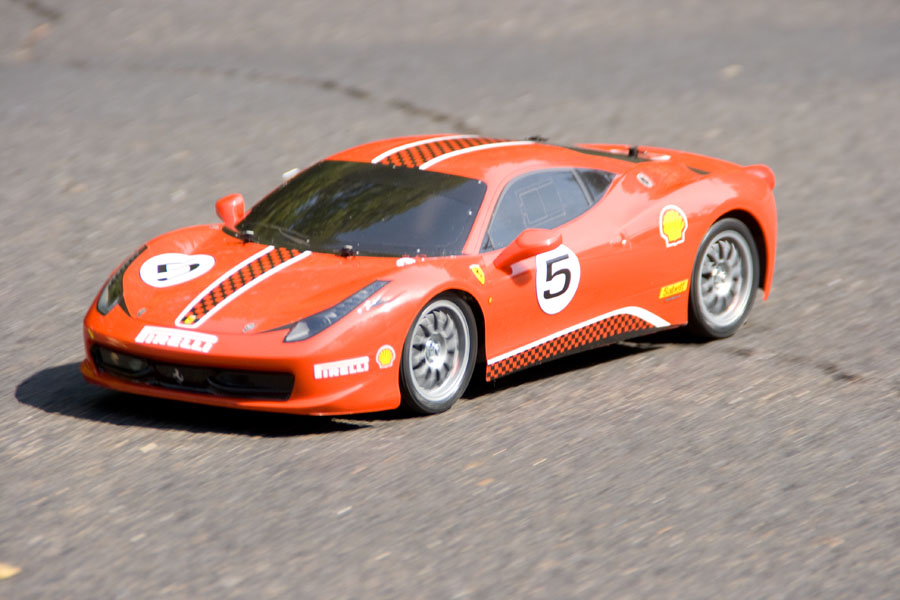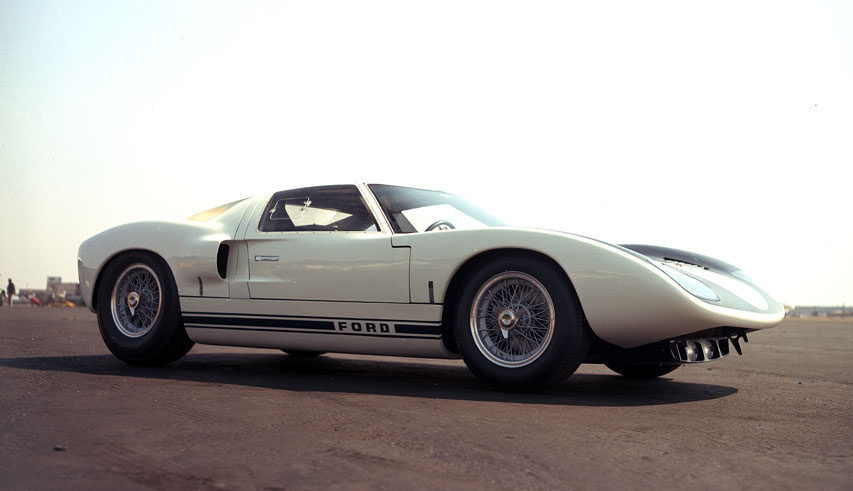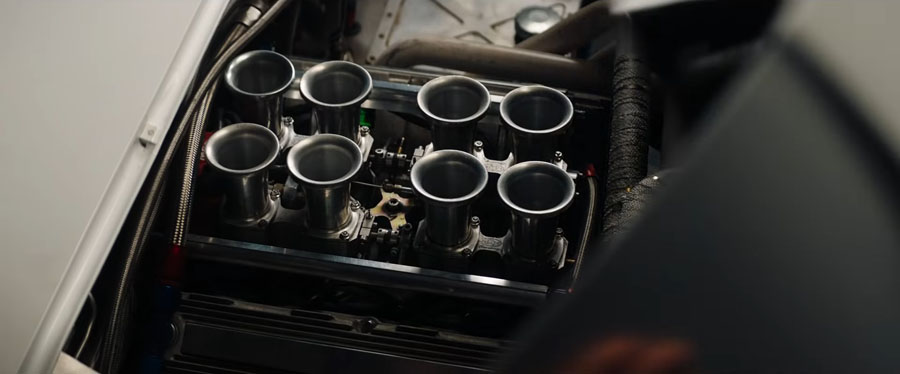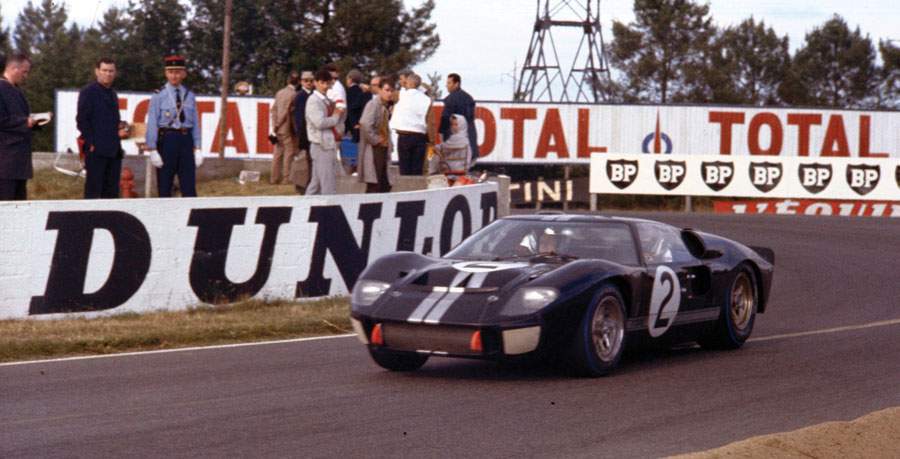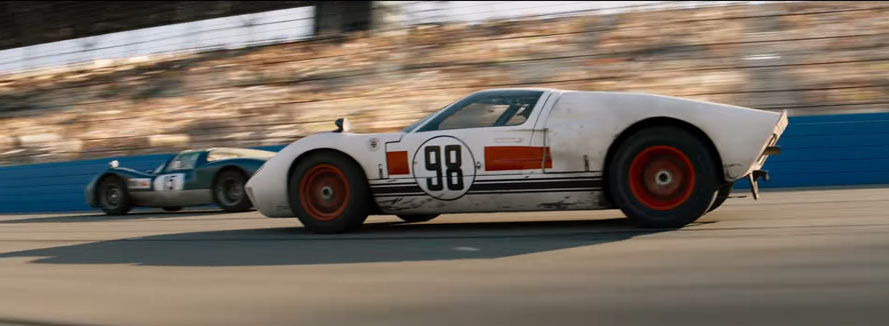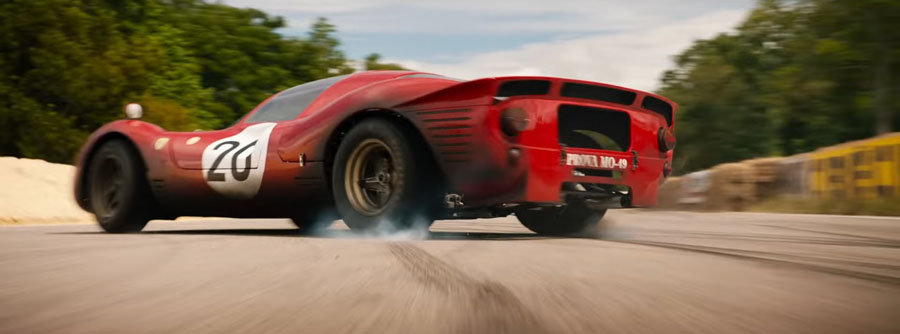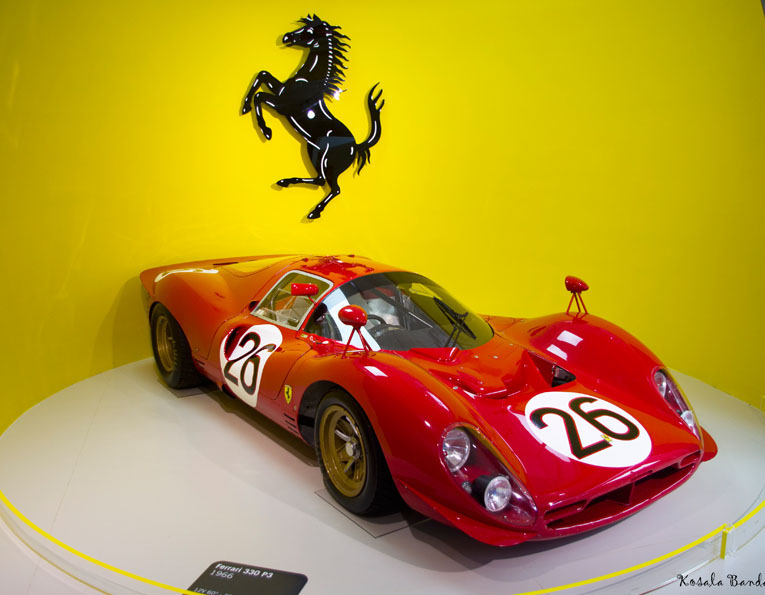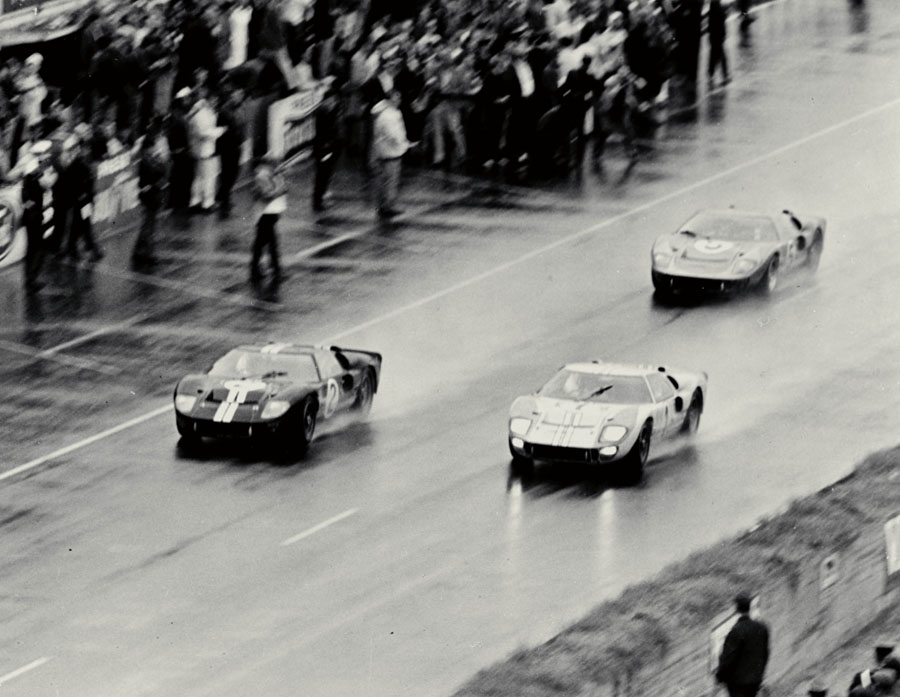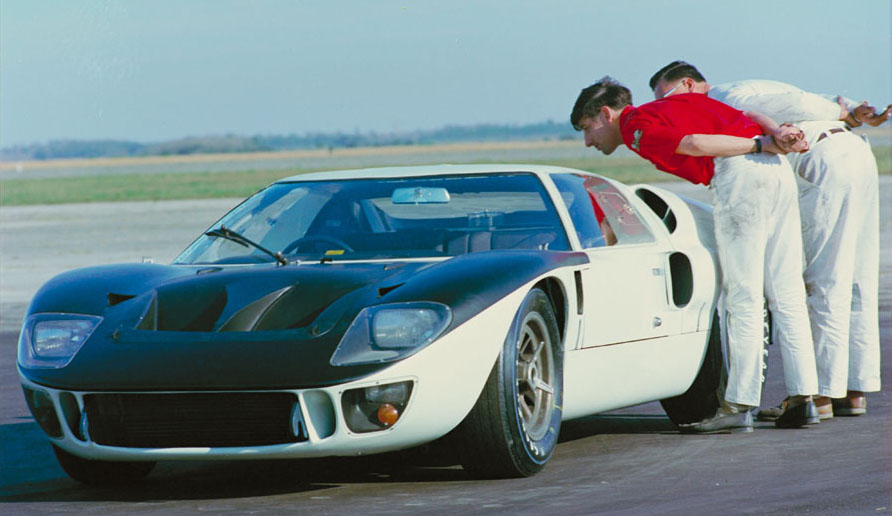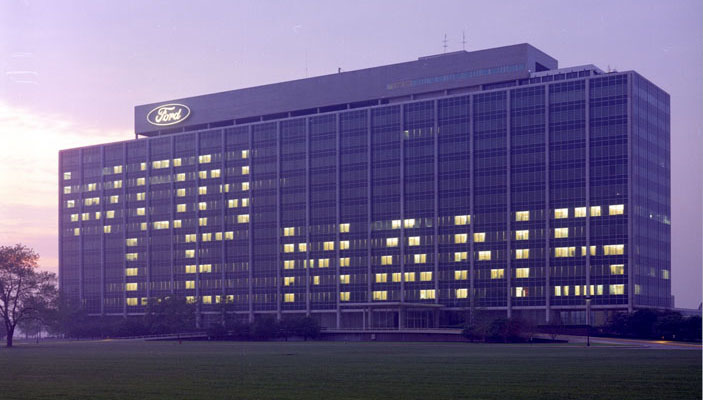In the coming weeks Hollywood is bringing to the big screen the tale of one of the biggest rivalries in all of racing history. The film is Ford v Ferrari, and it depicts the American manufacturer’s quest during the 1960s to unseat Ferrari as perennial champion of sports car racing’s crown jewel event: the 24 Hours of Le Mans. It features larger-than-life automotive icons like Carroll Shelby, Ken Miles, and Enzo Ferrari, plus plenty of spectacular racing action, intrigue, danger, triumph and tragedy, all set against sports car racing’s most famous race during the sport’s most heroic era. It’s the kind of epic you would expect Hollywood to invent…except it didn’t have to, because this story is true! And best of all, it features a dazzling lineup of some of the most beautiful, charismatic and historically significant cars of all time, headlined by the explosive Ford GT40 and Ferrari’s seductive 330 P3. Not since Steve McQueen’s classic Le Mans nearly 50 years ago has there been a racing film with this much potential. There is already Oscar buzz brewing!
We wanted to do something to celebrate the film and its four-wheeled heroes—something with an RC Car Action twist. So we thought we’d grab the RC versions the Ford and Ferrari in their modern incarnations—cars that have battled each other on the same Le Mans course since 2016, which just so happens to be the 50th anniversary of the epic duel depicted in the movie. Representing the Ford camp is American powerhouse Traxxas which (appropriately enough) hails from just outside Dallas, Texas—just a few miles from where Carroll Shelby himself was raised. Representing the Ferrari is Tamiya who, like the Italian supercar manufacturer itself, is known for exotic designs and rich history. We specified models that a fan of any experience level could easily buy and drive to recreate their own Ford v Ferrari battle in RC. As such, these are turnkey ready-to-run cars—user-friendly and affordable, and packing plenty of reliable speed and fun.
CAPTURING THE LOOK
Both models come with fully decorated bodies from the factory. In Tamiya’s case that means a Ferrari 458 Challenge, the car used for Maranello’s factory spec series from 2011 through 2017. Some 400 pounds lighter than a 458 road car, the Challenge is essentially a Le Mans-spec GT3 car without the fender flares and rear wing. Tamiya’s comes bathed in Rosso Corsa (“racing red”)—the only color a Ferrari race car should ever be painted! It also comes decked out in authentic-looking Pirelli and Shell decals like the competitors in the Challenge series, and features replicas of the center-lock wheels seen on the race cars, accurate down to the BBS logos (although they are 26mm wide at all four corners rather than staggered as they are on the actual car.) Those wheels and the side mirrors go a long way to completing the realistic look of the Ferrari.
Tamiya does a great job capturing the look of the Italian beauty. Little touches like the side mirrors and BBS wheels really help finish off for the Ferrari.
Traxxas comes to the line with an impressively accurate rendition of the Ford GT introduced in 2017, including the signature separate buttress C-pillar design and the aerodynamic body channels which required Traxxas to patent a special new molding technique. Other cool extras include injection-molded exhaust tips and accurate taillights. Traxxas chose the standard aluminum wheel rather than the optional (and ultra-exotic) carbon fiber wheels, but they are accurate and have simulated brake discs and calipers behind them—a nice touch. The treaded tires are grippy, and the width is properly staggered—26mm in front, 30mm in the rear.

Few cars make as striking an impression as the Ford GT. The buttress C-pillars and deep aerodynamic channels in the body required an all-new molding technology from Traxxas. It works beautifully because the this version is a stunner.
PROVEN PERFORMERS
Both cars are based on chassis we’re quite familiar with—the Traxxas 4-Tec 2.0 for the Ford, and Tamiya’s TT01ES for the Ferrari. Both feature molded tub with shaft drive and sealed gear differentials, and come with brushed motors and speed controls installed along with radio gear befitting an RTR. Tamiya’s TT01 chassis has been around for quite a while and in that time has seen numerous upgrades and revisions; that sort of continuous refinement is one of Tamiya’s greatest strengths as a brand. The ES is the economy-minded RTR version of the TT01 but its performance is good right out of the box—reasonably quick and with sharp turn-in that blends to a neutral slide as the treaded tires start to give up. And because it remains fundamentally the same layout as all TT01s countless parts are available and can be added to this chassis at any time, giving it tremendous upgrade potential.
The 4-Tec 2.0 comes with some performance-enhancing advantages. The Titan 12-turn motor is noticeably punchier than the 540 can motor that comes in the Tamiya Ferrari, in part because the Traxxas is set up to run on a 7-cell flat pack (as opposed to 6 cells for the Tamiya). The Traxxas speed control is also factory-set accept a 2-cell Lipo. The power system, radio, and servo are waterproof so the elements won’t put a damper on the fun. Speaking of dampers, the ones Traxxas includes are oil-filled to better soak up bumps. Traxxas Stability Management (TSM)—the company’s proprietary driver-selectable integrated traction and stability control system—comes standard, which allows you to dial up your preferred balance of spin resistance versus tail-out fun. It’s helpful for beginners and heavy-trigger fingers, especially with the treaded tires on unprepared surfaces where cars like these will spend most of their time.
The Chassis designs are effectively mirror images of one another, swapping sides for the motor and battery location but otherwise sharing very similar nylon tub and shaft-drive layouts. The Traxxas has staggered tire sizes—its 30mm rears with less offset contributing to its wider stance (200mm versus Tamiya’s 190mm.)
Star Power Meets Horsepower
Not since 2013’s Rush has motor racing been in the cinematic spotlight in a serious way, and Ford v Ferrari looks poised easily surpass that film. Why? It starts with the cast headlined by a pair of Oscar winners: Christian Bale as driver/engineer Ken Miles and Matt Damon as automotive icon Carroll Shelby. To that you can add an impressive supporting cast, which includes some legitimate automotive star power in the form of racer Alex Gurney portraying his legendary father Dan, rallycross ace and stunt driver Tanner Foust as Ronny Bucknum, and Top Gear’s “The Stig” (aka race driver Ben Collins) as Denny Hulme.
Rivals for the Ages
Fantastic as that cast looks, it’s really the cars that are the biggest stars, and from the pre-release footage it seems the production team did an outstanding job of replicating the various evolutions of the GT40, plus its rival Ferrari, and many other exceptional period vehicles.
The Mk I is easily identified by its wire spoke wheels and its Weber-carbed small-block.
The burly Mk II with its big-block 427 delivered the sought-after Le Mans win (Top) and performs much of the racing action in the film (directly above).
The antagonist in the film is widely considered one of the most beautiful racing cars ever constructed—the exquisite Ferrari 330 P3. [Photo by Kosala Bandara via Wikimedia Commons]
A Showdown Three Years in the Making
Ford v Ferrari isn’t just your typical ‘David slays Goliath’ story. Historically speaking it’s actually more of a ‘two Davids hired by Goliath to go settle a grudge with another Goliath’-type story, but that doesn’t detract from the off-track drama or the on-track excitement, both of which are fierce! The story begins with a business deal gone bad that turned into a feud between automotive titans. In 1963 Henry Ford II was in negotiations with Enzo Ferrari to purchase the Italian sports car manufacturer. The deal went south when Ford informed him that, as a Ford Motor Co. subsidiary, the Ferrari team would not be allowed to compete in any racing series against existing Ford-branded teams, thereby excluding them from events like the Indianapolis 500. Enzo Ferrari walked out, grievously offending Henry Ford II in the process. Ford resolved to get revenge by humiliating Ferrari at the racing events he most prized, starting with Le Mans.
Ford’s 1-2-3 sweep of Le Mans in 1966 capped off a 3-year crusade to vanquish the dominant Ferrari team.
To engineer his quest for vengeance Ford went on a three-year no-expense-spared crusade to develop a Ferrari-crushing supercar called the GT40, spearheaded by Britain-based Ford Advanced Vehicles (FAV) run by John Wyer. Its debut for the 1964 season showed flashes of speed, but persistent reliability issues plagued the car throughout the year. Ferrari continued to shine, winning Le Mans and the FIA sports car championship for the 5th consecutive year while Ford fumed. At the end of the season Ford pulled the GT40 project from FAV’s control and shipped the cars to Carroll Shelby’s Venice, California shop with a blank check and one commandment: Do whatever it takes to beat Ferrari. Shelby judged that what it would take was hard-nosed race driver and engineer Ken Miles. The two began sorting out the car over the winter, and in February of ’65 they took it racing at the Daytona 2000km race and won but reliability issues with the high-strung 289 V-8 soon reemerged so Shelby looked to his own Cobra sports car for the solution.
Shelby’s engineers shoehorned a NASCAR-style 427 into the back of the GT40 Mk II, producing 220mph top speeds on the Mulsanne Straight and vastly improved reliability.
Just as he had done with the Cobra, he upgraded the GT40’s small-block 289 to big-block 427, Ford’s NASCAR race motor. The extra displacement allowed the GT40 to rocket down the 3.7-mile long Mulsanne Straight at nearly 220mph and with much less stress on the engine. Ultimately the cars dropped out of the ’65 race with gearbox trouble, but the engines held up and offered a crucial power advantage over Ferrari. A stronger gearbox was built and aerodynamic and braking improvements were added to help with added weight, resulting in the GT40 Mk II which debuted at Daytona in ’66. It was a game-changer; it easily swept the top three spots. A month later Ford swept at Sebring too, setting the stage for an epic showdown at Le Mans. The strength of the 427 was bolstered by strength in numbers, with a virtual army of Mk IIs invading French soil. Eight Mk IIs entered the 1966 24 Hours—three by Shelby’s team, three more built by Shelby for NASCAR powerhouse team Holman & Moody, and two prepped by FAV for British team Alan Mann Racing. Just three of the eight finished, but they finished 1-2-3! And as icing on the cake all three Ferrari 330 P3s failed to finish!
After spending untold millions on the quest Ford was not shy about touting their Le Mans victory at their Dearborn, MI corporate HQ.
Ford’s 1966 triumph would kick off a golden era for the brand. Shelby returned in ’67 against a resurgent Ferrari team, but edged out a repeat win with American racing legends Dan Gurney and AJ Foyt in the a new Mk IV GT40, setting a record-shattering pace with a pair of Ferrari P4s nipping at their heels. The program was handed back to John Wyer for 1968, now heading up a private team with sponsorship from Gulf Oil. He would chalk up two more wins for the GT40 in ’68 and ’69, capping an extraordinary 4-year sweep for the overall win by a single model that remains a record even 50 years later.
FINAL THOUGHTS
Unlike in 1966, this isn’t an all-out competition between the Ford and Ferrari. Traxxas’ Ford offers more performance and features in stock form, but Tamiya has plenty of upgrade potential, and if you spend wisely you wouldn’t have much trouble getting it to run right with the Traxxas for just a few extra bucks. But that kind of misses the point of both of these cars, which is mainly to look great and provide quick, reliable fun with incredible scaler styling. Tamiya’s 458 Challenge offers the scintillating looks of the Ferrari while Traxxas nails the Ford’s futuristic supercar; which you pick probably boils down to styling and whether you pledge allegiance to the Blue Oval or the Prancing Horse. But spoiler alert if you count yourself among the Ferrari tifosi—you’re not going to like how next month’s movie ends!
TEXT AND PHOTOS BY MATT BOYD, WITH ADDITIONAL IMAGERY COURTESY OF FORD MEDIA CENTER AND 20TH CENTURY FOX
The post Ford v Ferrari—Rivals in Any Scale appeared first on RC Car Action.

